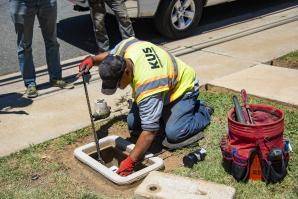As I’m writing this, the rain is pounding down, a dramatic reminder that California surely does have a winter season. By the time you read this, I’m hoping spring, and the traditions that go with it, will have arrived. One annual spring ritual is the graduation of our many high school students, eager to start a new chapter of their lives. Many will be rushing to the mailbox, looking for acceptance letters from the colleges they applied to last fall.
Locally, UC Davis received 109,000 applications for next year, while Sac State has received 35,000. Nationally, college applications are up 21 percent, according to the National Center for Educational Statistics. Some of that increase comes from more interest among minority students, which is up 16 percent this year, and from students who are the first in their family to go to college, which has increased by 20 percent. One reason is that schools are actively recruiting those students. Less reliance on standardized tests has also boosted those application numbers.
These statistics are encouraging and show how an increasing number of students see higher education as important for their personal success. But there is another way to look at the numbers. According to Common App, a nonprofit organization that streamlines the application process for 900 higher education institutions, more than half (57 percent) of all the applications it processed were from students in very affluent ZIP codes, the top 20 percent in the country. Only six percent were from students in low-income ZIP codes.
The expense of tuition and housing and the prospect of long-term debt certainly play a role in discouraging students in poor neighborhoods from thinking about going to college. But it’s also true that college simply isn’t the right career path for everyone. Some people can’t imagine themselves working in an office. Some find greater satisfaction in hands-on work. They are more comfortable with a wrench, a paint brush or a culinary pan in their hands. For some, learning a trade they can rely on is more satisfying than earning an academic degree.
Career Technical Education programs in community colleges are one path for students to learn those skills. The Los Rios Community College District, for example, offers 120 technical courses in fields as diverse as transportation management, manufacturing logistics, computerized robotics and aviation mechanics. But there are many students who need a more basic first step that teaches both the technical and the soft skills they need to get started in a field. An increasing number of them are finding that first step in trade schools, in some cases even while they are still in high school.
The Sacramento Regional Builders Exchange exposes over 4,000 students a year to career opportunities in the construction trades through a partnership between its nonprofit CIE Foundation and 40 high schools throughout Northern California. Most importantly, about half of the students are from low-income neighborhoods. Late this summer, an old furniture store in the low income neighborhood of Del Paso Heights will be turned into the Capital College and Career Academy, a charter school to prepare students for a career in construction. Far from a classroom exercise in swinging a hammer, the school’s curriculum will have students spend some of their time off-campus on job sites, teaming up with mentors to also learn vital practical skills, including teamwork and communication. The goal is to have youth in a job or enrolled in a program that leads to a career within six months of graduation.
The location of this school, in one of Sacramento’s most disadvantaged areas, was not a coincidence. It offers more than job skills to youth who need them the most. It and schools like it also offer hope for a stable economic future for youth who may not otherwise see opportunities available to them.
In a recent conversation with Comstock’s editorial board, Sacramento Police Chief Kathy Lester noted that creating jobs for youth is one significant way our community can reduce crime, especially in low-income neighborhoods. But we also need a new generation of trade school graduates to fill gaps in the job market as older workers retire. The construction industry, for example, is gaining only one new worker for every five who retire — surprising since the average wages for tradesmen like plumbers and electricians are double the minimum wage common in the hospitality or warehouse industry.
To be sure, we need the advanced skills of college graduates to support a growing and more sophisticated economy. But we also need more people wearing tool belts. In the practical world, where are you going to find a plumber when you need one? Chances are they will be a trade school graduate.
Winnie Comstock-Carlson
President and Publisher
–
Stay up to date on business in the Capital Region: Subscribe to the Comstock’s newsletter today.
Recommended For You

The Lasting Agreement
California’s long legacy of trying to solve its water problem
No one owns water in California, making collaboration and
negotiation between water management players crucial.

As California’s Drought Deepens, Water Use Drops Only 1.8 Percent
Officials warn that next year’s cuts in water supply could go even deeper as severe drought grips nearly 90 percent of California. Residents of the North Coast and Bay Area conserved more than Southern Californians did.

How California Is Managing Its Water Supply
Jessica Law became executive director of the Water Forum in January. Comstock’s spoke to Law about the group’s priorities as the region deals with another drought.

Getting Smart About Water
City of Wheatland installing over 1,200 smart water meters
Upgrades in water meters are helping to reduce water waste, but
installation of new infrastructure can be slow
and difficult to fund.





